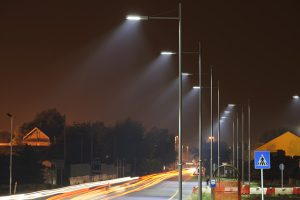Feedback from the ESOLi project on intelligent street lighting
The European project, ESOLi (Energy Saving Outdoor Lighting), which aims to promote intelligent solutions for street lighting, held a conference in Frankfurt on the 17th of April 2012. Sabine Pillar, from the Berlin Energy Agency tells us what was discussed.
What knowledge has the ESOLi project gathered on intelligent street light (ISL), and how can this help municipalities?
ESOLi (Energy Saving Outdoor Lighting) is supported by the “Intelligent Energy – Europe” program of the European Union, with the aim of promoting intelligent solutions for street lighting Europe-wide. The project offers information and advice to municipalities on specific public lighting issues and supports them by developing a series of practical tools.
Now we are in the second part of the project duration and results that have been achieved are e.g.: a Best practice catalogue which is available on the project website, more than 30 national workshops, an international conference and a training seminar at the Light+Building as well as the ESOLi newsletter which is coming to its fourth edition. This year we will organize 2 study visits and 14 training seminars about ISL all over Europe.
What are the major challenges faced by cities in implementing intelligent street lighting?
Usually the biggest obstacle is that municipalities do not have sufficient funds to face the initial investment in ISL, although a lot of them are aware of the long term benefits. The public lighting systems are very often old, and if we are talking about installing ISL, they need to be renovated, which implies high investment costs. The payback period is variable but usually more than 5 years, depending on many factors, although savings on the electricity bill and on lower maintenance cost are immediate, as so are also the social/environmental benefits. An uncertainty factor for decision makers is the abundance of offered technologies and often they don’t have sufficient information for the choice. Additionally, there are several concerns regarding LED technologies.
What are the lessons learnt? What must cities take into account when implementing ISL systems?
It is always important to compare several solutions and to evaluate possible advantages. A good way could be to make a smaller pilot project to test the chosen new technology (ISL, LED etc.) and widen the application to more and more light points only if the pilot project gives satisfactory results.
What were the trends in ISL as highlighted by the conference?
An increasing number of municipalities are now replacing their old fashioned and inefficient street lighting systems by highly-efficient Light Emitting diode (LED)-street lighting systems. The trend is going towards implementing controllable so called “smart or intelligent lighting systems”, providing the respective quantity of energy needed at the particular time and location. E.g. the city of Düsseldorf is in the course of implementing a traffic-related street lighting system for the Airport feeder road. The combination of such technologies with professional monitoring systems can make them even more profitable for municipalities.
What were the conclusions of the conference?
From the practical point of view, the conclusion is that a lack of knowledge and experience in the modernization of street lighting systems constitutes a barrier for many municipalities and communal energy suppliers. To overcome existing restraints and to foster the use of energy-saving street lighting across Europe it is important to involve both groups of actors – the municipalities and the utilities – in the project planning process for future innovative projects on street lighting.
More information on the project can be found at www.esoli.org


